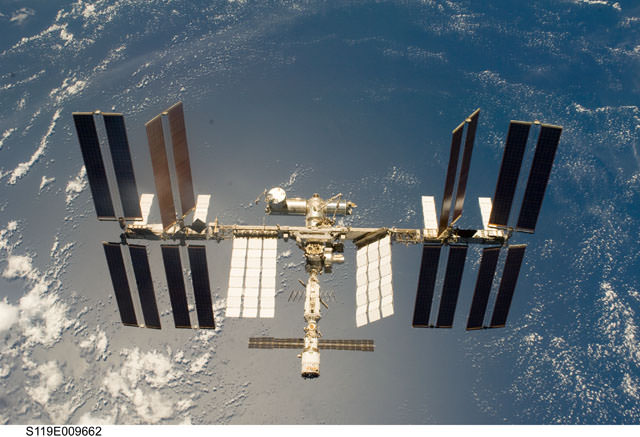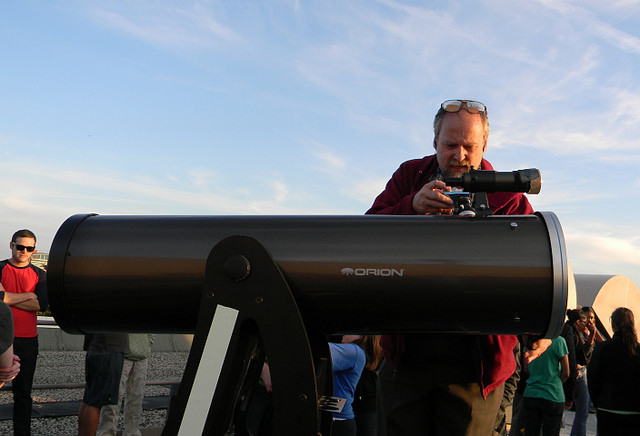Host: Fraser Cain
Guests: Mike Simmons from Astronomers without Borders, Nicole Gugliucci, Jason Major, Casey Dreier, Brian Koberlein, Nancy Atkinson, Morgan Rehnberg, David Dickinson
Continue reading “Weekly Space Hangout – January 17, 2014: Astronomers Without Borders, & Jelly Donuts”
The Rock that Appeared Out of Nowhere on Mars
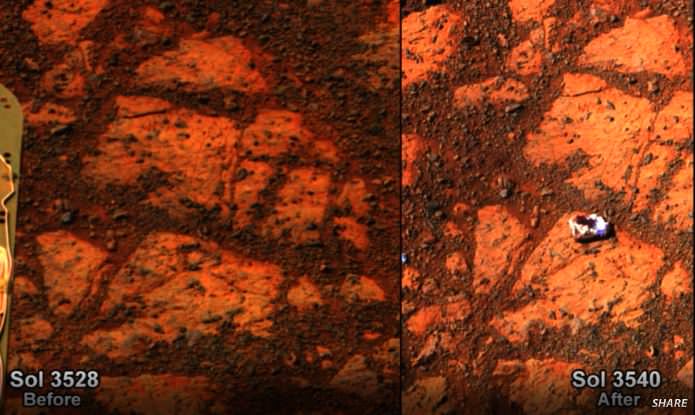
During last night’s celebration at the Jet Propulsion Laboratory of ten years of the Mars Exploration Rovers, mission principal investigator Steve Squyres shared several stories about the exploration and discoveries made by the rovers Spirit and Opportunity since they landed on Mars in 2004. An intriguing recent mystery is a strange rock that suddenly appeared in photos from the Opportunity rover in a spot where photos taken just 12 sols earlier showed no rock.
“One of the things I like to say is that Mars keeps throwing new things at us,” Squyres deadpanned.
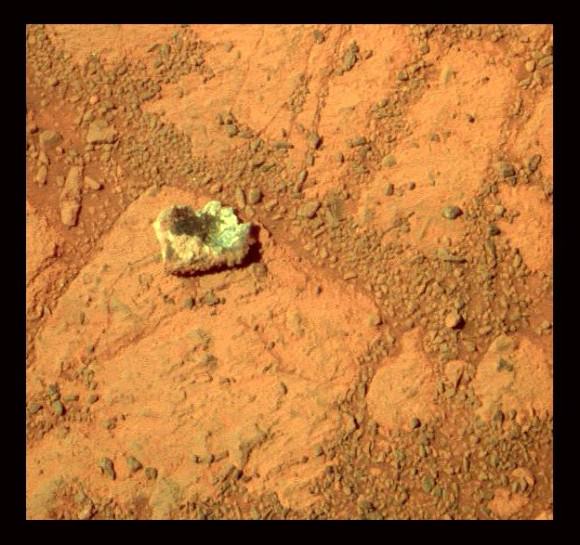
Squyres described the rock as “white around the outside, in the middle there’s low spot that is dark red. It looks like a jelly donut,” he said. “And it appeared. It just plain appeared and we haven’t driven over that spot.”
They’ve named it “Pinnacle Island,” and the team is contemplating a few ideas of why the rock mysteriously showed up.
“One theory is that we somehow flicked it with a wheel,” Squyres said. “We had driven a meter or two away from here and somehow maybe one of the wheels managed spit it out of the ground. That’s the more likely theory.”
The other?
“The other theory is that there might be a smoking hole in the ground nearby and this may be crater ejecta. But that one is less likely,” Squyres said.
Another idea suggested by others is that it may have tumbled down from a nearby rock outcrop.
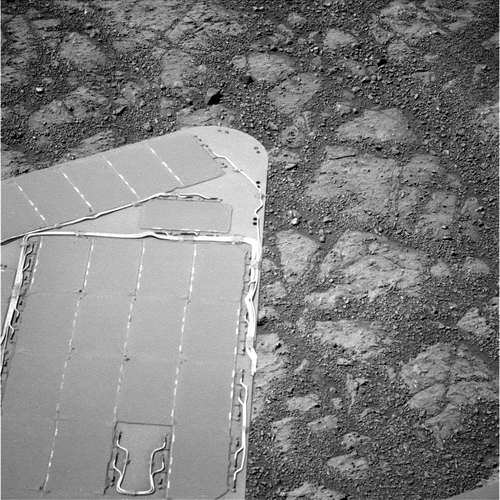
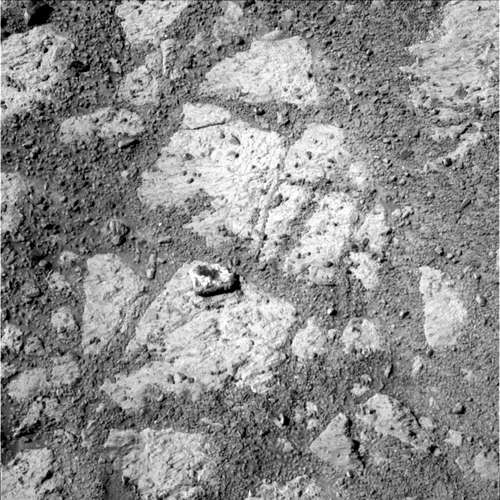
But as intriguing as the sudden appearance of the rock is what the team is finding out about it.
“We are as we speak situated with the rover, with its instruments, making measurements on this rock. We’ve taken pictures of both the donut part and the jelly part,” Squyres said. “The jelly part is like nothing we’ve seen before on Mars. It’s very high in sulfur and magnesium and it has twice as much manganese as anything we’ve seen before. I don’t know what any of this means. We’re completely confused, everybody on the team is arguing and fighting. We’re having a wonderful time!”
But that’s the beauty of this mission, Squyres said.
“I used to have this comforting notion that at some point, we could sit back and say ‘we did it, we’re finished, we’ve learned everything we could about this location.’ But Mars is not like that. It keeps throwing new things at us.”
“And what I’ve come to realize,” Squyres concluded, ” – and it was true when we lost Spirit and it will be true when we lose Opportunity — there will always be something tantalizing just beyond our reach that we just won’t get to. That’s just the nature of exploration, and I feel so very fortunate to have been part of this mission.”
You can watch the entire replay of the celebration below, and read a great look back at the past 10 years from Stuart Atkinson’s Road to Endeavour blog.
Astrophoto: The Red Rectangle in Space
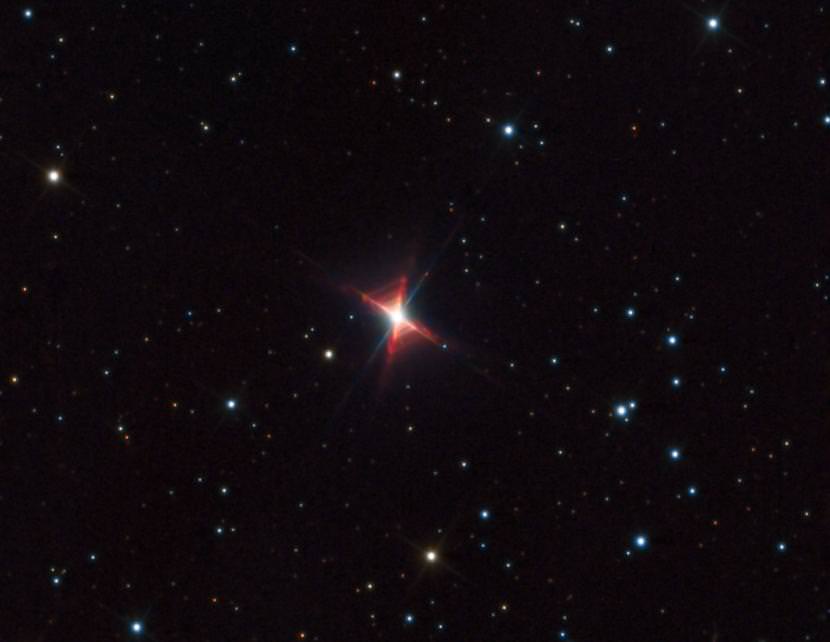
Due to gravity, most objects in space are spherical — whether it’s round planets and stars or swirling spiral galaxies. That’s why this object, the Red Rectangle Nebula, or HD 44179, is so intriguing.
“The overall shape of the nebula is a puzzle for astronomers to figure out,” said astronomer Adam Block from the Mount Lemmon SkyCenter at the University of Arizona, via email. “The leading theory suggests that bipolar, cone-shaped, and periodic outflows, when viewed in profile as we do, may give the shape we see. The intense red color still remains a bit of a mystery.”
From most “smaller” ground based telescopes, this object really does look like a rectangle, but images from space, such as from the Hubble Space Telescope, reveal that rather than being rectangular, is shaped like an X with additional complex structures of spaced lines of glowing gas, a little like the rungs of a ladder. This stunning new image from Adam also captures these features.
He said he wanted to know what it really looked like from a ground-based telescope using full color (broad band) filters.
“I didn’t know, but now I do,” Adam said. “It is a tiny tiny thing; but it was wonderful to see it develop from the raw data to this rendered result. The central star is very bright and nearly overwhelms the interesting parts of the nebula. In addition to its size, the central star is a big challenge to tame.”
See a larger version and find out more of the observing details here.
Compare the Space Station’s Internet Speed with Yours
We now take it for granted that astronauts on the International Space Station can tweet and post things on Facebook and G+ live from space, but it wasn’t always so. Before January of 2010, any emails, news, or Twitter messages were sent to and from the ISS in uplink and downlink packages, so for example, Twitter messages from the astronauts were downlinked to mission control in Houston, and someone there posted them on the astronauts’ Twitter accounts. But now they have “live” internet. However, as you can imagine, there are no fiberoptic cables hooking up to the ISS, so the internet speeds aren’t blazing fast. Find out how fast in this latest video update from NASA’s Space to Ground, a weekly update on what’s happening aboard the ISS.
Extend ISS to 2050 as Stepping Stone to Future Deep Space Voyages – Orbital VP/Astronaut tells Universe Today
The International Space Station could potentially function far beyond its new extension to 2024. Perhaps out to 2050. The ISS as seen from the crew of STS-119. Credit: NASA
Story updated[/caption]
WALLOPS ISLAND, VA – Just days ago, the Obama Administration approved NASA’s request to extend the lifetime of the International Space Station (ISS) to at least 2024. Ultimately this will serve as a stepping stone to exciting deep space voyages in future decades.
“I think this is a tremendous announcement for us here in the space station world,” said Bill Gerstenmaier, associate administrator for NASA’s Human Exploration and Operations Mission Directorate, at a press briefing on Jan. 8.
But there’s really “no reason to stop it there”, said Frank Culbertson, VP at Orbital Sciences and former NASA astronaut and shuttle commander, to Universe Today when I asked him for his response to NASA’s station extension announcement.
“It’s fantastic!” Culbertson told me, shortly after we witnessed the picture perfect blastoff of Orbital’s Antares/Cygnus rocket on Jan. 9 from NASA’s Wallops launch facility in Virginia, bound for the ISS.
“In my opinion, if it were up to me, we would fly it [the station] to 2050!” Culbertson added with a smile. “Of course, Congress would have to agree to that.”
Gerstenmaier emphasized that the extension will allow both the research and business communities to plan for the longer term and future utilization, be innovative and realize a much greater return on their investments in scientific research and capital outlays.
“The station is really our stepping stone,” Robert Lightfoot, NASA Associate Administrator, told me at Wallops following Antares launch.
The Alpha Magnetic Spectrometer (AMS) – which is searching for elusive dark matter – was one of the key science experiments that Gerstenmaier cited as benefitting greatly from the ISS extension to 2024. The AMS is the largest research instrument on the ISS.
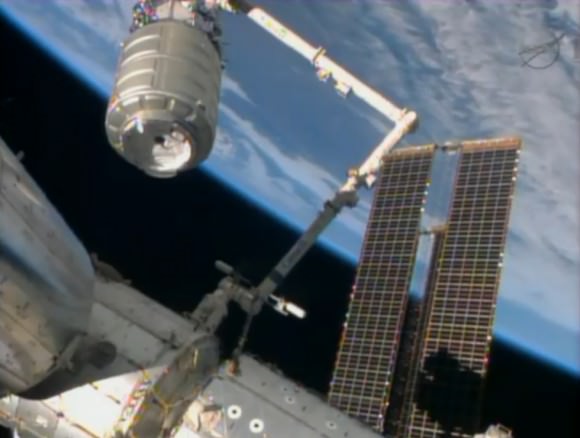
The extension will enable NASA, the academic community and commercial industry to plan much farther in the future and consider ideas not even possible if the station was de-orbited in 2020 according to the existing timetable.
Both the Antares rocket and Cygnus cargo freighter are private space vehicles developed and built by Orbital Sciences with seed money from NASA in a public-private partnership to keep the station stocked with essential supplies and research experiments and to foster commercial spaceflight.
So I asked Culbertson and Lightfoot to elaborate on the benefits of the ISS extension to NASA, scientific researchers and commercial company’s like Orbital Sciences.
“First I think it’s fantastic that the Administration has committed to extending the station, said Culbertson. “They have to work with the ISS partners and there is a lot to be done yet. It’s a move in the right direction.”
“There is really no reason to stop operations on the space station until it is completely no longer usable. And I think it will be usable for a very long time because it is very built and very well maintained.”
“If it were up to me, we would fly it to 2050!”
“NASA and the engineers understand the station very well. I think they are operating it superbly.”
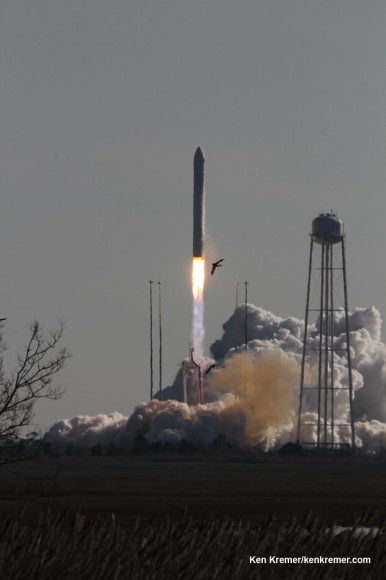
Credit: Ken Kremer – kenkremer
“The best thing about the station is it’s now a research center. And it is really starting to ramp up. It’s not there yet. But it is now finished [the assembly] as a station and a laboratory.”
“The research capability is just starting to move in the right direction.”
The Cygnus Orbital 1 cargo vehicle launched on Jan. 9 was loaded with approximately 2,780 pounds/1,261 kilograms of cargo for the ISS crew for NASA including vital science experiments, computer supplies, spacewalk tools, food, water, clothing and experimental hardware.
The research investigations alone accounted for over 1/3 of the total cargo mass. It included a batch of 23 student designed experiments representing over 8700 students sponsored by the National Center for Earth and Space Science Education (NCESSE).
“So extending it [ISS] gives not only commercial companies but also researchers the idea that ‘Yes I can do long term research on the station because it will be there for another 10 years. And I can get some significant data.”
“I think that’s really important for them [the researchers] to understand, that it will be backed for that long time and that they won’t be cut off short in the middle of preparing an experiment or flying it.”

“So I think that first of all it demonstrates the commitment of the government to continue with NASA. But also it presents a number of opportunities for a number of people.”
What does the ISS extension mean for Orbital?
The purpose for NASA and Orbital Sciences in building Antares and Cygnus was to restore America’s ability to launch cargo to the ISS – following the shutdown of NASA’s space shuttles – by using commercial companies and their business know how to thereby significantly reduce the cost of launching cargo to low Earth orbit.
“As far as what it [the ISS extension] means for Orbital and other commercial companies – Yes, it does allow us to plan long term for what we might be able to do in providing a service for NASA in the future,” Culbertson replied.
“It also gives us the chance to be innovative and maybe invest in some improvements in how we can do this [cargo service] – to make it more cost effective, more efficient, turnaround time quicker, go more often, go a lot more often!”
“So it allows us the chance to think long term and make sure we can get a return on our investment.”
What does the ISS extension mean for NASA?
“The station is really our stepping stone,” Robert Lightfoot, NASA Associate Administrator, told Universe Today. “If you use that analogy of stepping stones and the next stone. We need to use this stone to know what the next stone looks like. So we can get ready. Whether that’s research or whether that things about the human body. You don’t want to jump off that platform before you are ready.”
“We are learning every day how to live and operate in space. Fortunately on the ISS we are close to home. So if something comes up we can get [the astronauts] home.”
The ISS extension is also the pathway to future exciting journey’s beyond Earth and into deep space, Culbertson and Lightfoot told Universe Today.
“It actually also presents a business opportunity that can be expanded not just to the station but to other uses in spaceflight, such as exploration to Asteroids, Mars and wherever we are going,” said Culbertson.
And we hope it will extend to other civilian uses in space also. Maybe other stations in space will follow this one and we’ll be able to participate in that.”
Lightfoot described the benefits for astronaut crews.
“The further out we go, the more we need to know about how to operate in space, what kind of protection we need, what kind of research we need for the astronauts,” said Lightfoot.
“Orbital is putting systems up there that allow us to test more and more. Get more time. Because when we get further away, we can’t get home as quick. So those are the kinds of things we can do.
“So with this extension I can make those investments as an Agency. And not just us, but also our academic research partners, our industry partners, and the launch market too is part of this.”
He emphasized the benefits for students, like those who flew experiments on Cygnus, and how that would inspire the next generation of explorers!
“You saw the excitement we had today with the students at the viewing area. For example with those little cubesats, 4 inches by 4 inches, that they worked on, and got launched today!”
“That’s pretty cool! And that’s exactly what we need to be doing!
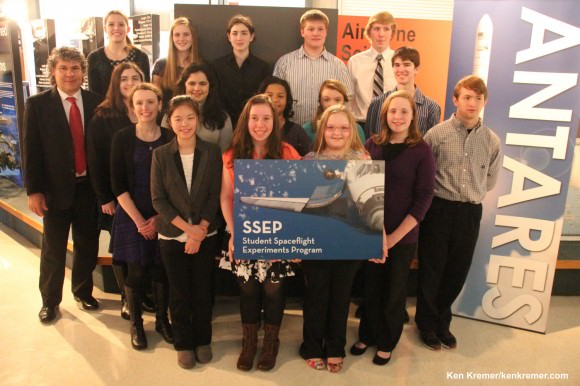
These are among the students benefiting from ISS extension
Science experiments from these students representing six schools across America were selected to fly aboard the Cygnus spacecraft which launched to the ISS from NASA Wallops, VA, on Jan . 9, 2014, as part of the Student Spaceflight Experiments Program (SSEP). Credit: Ken Kremer – kenkremer.com
“So eventually they can take our jobs. And as long as they know that station will be there for awhile, the extension gives them the chance to get the training and learning and do the research we need to take people further out in space.”
“The station is the stepping stone.”
“And it really is important to have this station extension,” Lightfoot explained to me.
The Jan. 9 launch of the Orbital-1 mission is the first of eight operational Antares/Cygnus flights to the space station scheduled through 2016 by Orbital Sciences under its $1.9 Billion Commercial Resupply Services (CRS) contract with NASA to deliver 20,000 kg of cargo to orbit.
Orbital Sciences and SpaceX – NASA’s other cargo provider – will compete for follow on ISS cargo delivery contracts.
The next Antares/Cygnus flight is slated for about May 1 from NASA Wallops.
In an upcoming story, I’ll describe Orbital Sciences’ plans to upgrade both Antares and Cygnus to meet the challenges of the ISS today and tomorrow.
Stay tuned here for Ken’s continuing Orbital Sciences, SpaceX, commercial space, Chang’e-3, LADEE, Mars and more news.

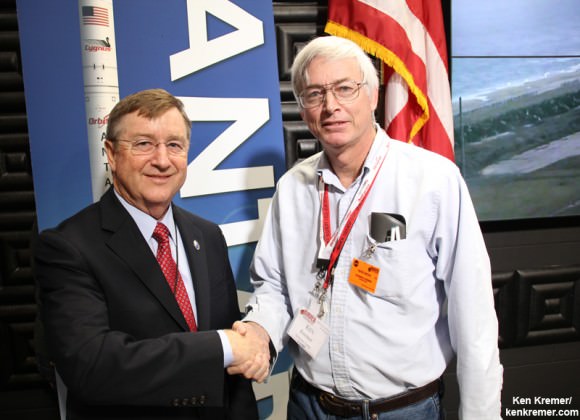
Some Planet-like Kuiper Belt Objects Don’t Play “Nice”
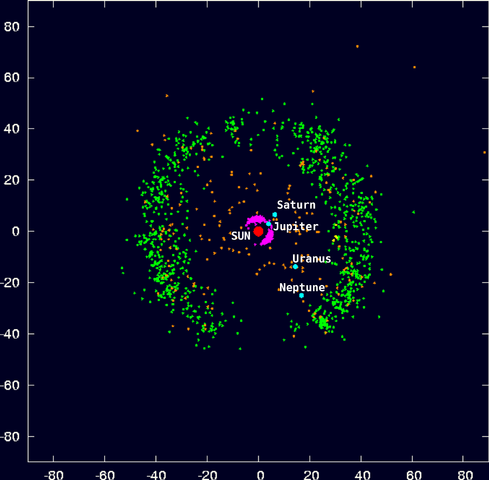
The Kuiper belt — the region beyond the orbit of Neptune inhabited by a number of small bodies of rock and ice — hides many clues about the early days of the Solar System. According to the standard picture of Solar System formation, many planetesimals were born in the chaotic region where the giant planets now reside. Some were thrown out beyond the orbit of Neptune, while others stayed put in the form of Trojan asteroids (which orbit in the same trajectory as Jupiter and other planets). This is called the Nice model.
However, not all Kuiper belt objects (KBOs) play nicely with the Nice model.
(I should point out that the model is named named for the city in France and therefore pronounced “neese”.) A new study of large scale surveys of KBOs revealed that those with nearly circular orbits lying roughly in the same plane as the orbits of the major planets don’t fit the Nice model, while those with irregular orbits do. It’s a puzzling anomaly, one with no immediate resolution, but it hints that we need to refine our Solar System formation models.
This new study is described in a recently released paper by Wesley Fraser, Mike Brown, Alessandro Morbidelli, Alex Parker, and Konstantin Baygin (to be published in the Astrophysical Journal, available online). These researchers combined data from seven different surveys of KBOs to determine roughly how many of each size of object are in the Solar System, which in turn is a good gauge of the environment in which they formed.
The difference between this and previous studies is the use of absolute magnitudes — a measure of how bright an object really is — as opposed to their apparent magnitudes, which are simply how bright an object appears. The two types of magnitude are related by the distance an object is from Earth, so the observational challenge comes down to accurate distance measurements. Absolute magnitude is also related to the size of an KBO and its albedo (how much light it reflects), both important physical quantities for understanding formation and composition.
Finding the absolute magnitudes for KBOs is more challenging than apparent magnitudes for obvious reasons: these are small objects, often not resolved as anything other than points of light in a telescope. That means requires measuring the distance to each KBO as accurately as possible. As the authors of the study point out, even small errors in distance measurements can have a large effect on the estimated absolute magnitude.
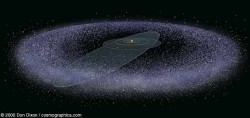
In terms of orbits, KBOs fall into two categories: “hot” and “cold”, confusing terms having nothing to do with temperature. The “cold” KBOs are those with nearly circular orbits (low eccentricity, in mathematical terms) and low inclinations, meaning their trajectories lie nearly in the ecliptic plane, where the eight canonical planets also orbit. In other words, these objects have nearly planet-like orbits. The “hot” KBOs have elongated orbits and higher inclinations, behavior more akin to comets.
The authors of the new study found that the hot KBOs have the same distribution of sizes as the Trojan asteroids, meaning there are the same relative number of small, medium, and large KBOs and similarly sized Trojans. That hints at a probable common origin in the early days of the Solar System. This is in line with the Nice model, which predicts that, as they migrated into their current orbits, the giant planets kicked many planetesimals out beyond Neptune.
However, the cold KBOs don’t match that pattern at all: there are fewer large KBOs relative to smaller objects. To make matters more strange, both hot and cold seem to follow the same pattern for the smaller bodies, only deviating at larger masses, which is at odds with expectations if the cold KBOs formed where they orbit today.
To put it another way, the Nice model as it stands could explain the hot KBOs and Trojans, but not the cold. That doesn’t mean all is lost, of course. The Nice model seems to do very well except for a few nagging problems, so it’s unlikely that it’s completely wrong. As we’ve learned from studying exoplanet systems, planet formation models are a work in progress — and astronomers are an ingenious lot.
What’s On The Far Side Of The Moon?
You probably know we only see one side of the Moon from the Earth. But for the majority of human history, we had no idea what the far side looked like.
Billions of years ago, our Moon was formed when a Mars-sized object smashed into the Earth, spinning out a ring of debris. This debris collected into the Moon we know today. It started out rotating from our perspective, but the Earth’s gravity slowed it down until its rotation became locked with the Earth’s, keeping one half forever hidden from our view.
It wasn’t until the space age that humans finally got a chance to see what’s on the other side. The first spacecraft to image the far side of the Moon was the Soviet Luna 3 probe in 1959, which returned 18 usable images to scientists. And then in 1965, the Soviet Zond 3 transmitted another 25 pictures of higher quality that gave much more detail of the surface. The first humans to actually see the far side with their own eyes, were the crew of Apollo 8, who did a flyover in 1968.
We now have high resolution cameras imaging every square meter, even the far side. And here’s the amazing surprise….
You would think that the far side of the Moon would look like the near side, but check out the two hemispheres…They’re totally different.
The near side of the has huge regions of ancient lava flows, called maria. While the far side is almost entirely covered in crater impacts. Planetary geologists aren’t sure, but it’s possible that the Earth used to have two Moons.
Billions of years ago, the second, smaller moon crashed into the far side of the Moon, covering up the darker maria regions.
And just to clarify things with Pink Floyd’s reference to the “Dark Side of the Moon”… Except for the occasional lunar eclipse, half of the Moon is always in darkness and half is always illuminated. But that illuminated half changes as the Moon orbits around us.

Just like half of the Earth is always in darkness, and half of every other large object in the Solar System. There’s no permanent “dark side” of the Moon. The side facing towards the Sun is lit up, and the side facing away is in shadows.
There are, however, some spots on the Moon which are in eternal darkness. There are craters at the north and south poles deep enough that the light from the Sun never illuminates their floors. In these places, It’s possible that there are reserves of ice that future space colonies could use for their supplies of water, air, and even rocket fuel.
Pink Floyd was right if you’re talking radio waves instead of visible light. The far side of the Moon is naturally shielded from the Earth’s radio transmissions, so it makes an ideal spot to locate a sensitive radio observatory.
I’ll see you in the permanently shadowed craters of the Moon.
Astronomers and Their Dobs: Paying a Twitter Tribute to John Dobson
12" of awesome Dobsonian love. Thanks #johndobson for the views! @universetoday @JPMajor pic.twitter.com/PLA321Vqf1
— Scott MacNeill (@scottiemacneill) January 16, 2014
Amateur astronomers love their Dobs. As we said in a previous article, “A Dobsonian is simplicity in itself; a simple set of optics on a simple mount. But don’t be fooled by this simplicity. Dobsonian telescopes are incredibly good and are great for amateurs and professional astronomers alike.”
And so, we were all saddened to learn of the passing of John Dobson, the inventor of this beloved telescope. We asked our followers on Twitter to tweet pictures of their Dobs, and our feed got flooded with pics and remembrances. See a bunch of our retweets below:
@universetoday Co-creators of http://t.co/F0j0xZo0g1 Jimi Lowrey and Dragan Nikin with Jimis 48" f/4 OMI pic.twitter.com/Mgr4KNOfjd
— DeepSkyForum (@DeepSkyForum) January 16, 2014
@universetoday (part of) me and my trustee 19-year old Dobsonian. Should have painted it black! :-} pic.twitter.com/AcVJT1A2GM
— Shahrin.Ahmad (Shah) (@shahgazer) January 16, 2014
@universetoday Here's my daughter's 6" f/8 'sidewalk telescope' that we built. RIP #johndobson pic.twitter.com/CpnvHTGYY0
— Brett Schaerer (@astrobug75) January 16, 2014
@universetoday commercial 6" and homemade 10" pic.twitter.com/ZRGokcCjeJ
— Paul Stewart (@astrostew) January 16, 2014
@universetoday here's @SalAstroSoc 14 inch #Dobsonian at our lady open day pic.twitter.com/WAe2LEf4Ju
— Salford Astronomical (@SalAstroSoc) January 16, 2014
Here's my 10-Inch #JohnDobson scope, with a homemade solar filter #DIY http://t.co/CMQ8u5dS30 @universetoday pic.twitter.com/MA0RcguCXc
— Jane Houston Jones (@jhjones) January 16, 2014
@universetoday Looking at PANSTARRS with my #dobsonian pic.twitter.com/lRp38TWh0i
— Peter Wakeford (@echempe) January 16, 2014
@universetoday Here's the pic of me and my dob that was on the back cover of my book! pic.twitter.com/HKwRRJdGvi
— Kelly Kizer Whitt (@Astronomommy) January 16, 2014
@universetoday My 8 inch #johndobson pic.twitter.com/T0bUINmjV1
— Kate Northcutt (@katenorthcutt) January 16, 2014
@universetoday Co-creator of http://t.co/F0j0xZo0g1 Dragan Nikin and his 25" f/5 Obsession pic.twitter.com/Iu3EAqB2hQ
— DeepSkyForum (@DeepSkyForum) January 16, 2014
The Art Guarino 10" Dobsonian @FrostyDrewOBSY #johndobson @universetoday ht @JPMajor pic.twitter.com/VJnQyQwp0B
— Frosty Drew OBSY (@FrostyDrewOBSY) January 16, 2014
@universetoday best thing I’ve ever bought. #johndobson pic.twitter.com/qtOizlvXo6
— Nathan Broussard (@ropeswing05) January 16, 2014
@universetoday Here's mine with infinite thanks to #johndobson for adding wonder and joy to my life. pic.twitter.com/mwmvVzuwBp
— Jennifer Rivera (@lasenorarivera) January 16, 2014
Nearby Brown Dwarf System May Harbor Closest Exoplanet to Earth
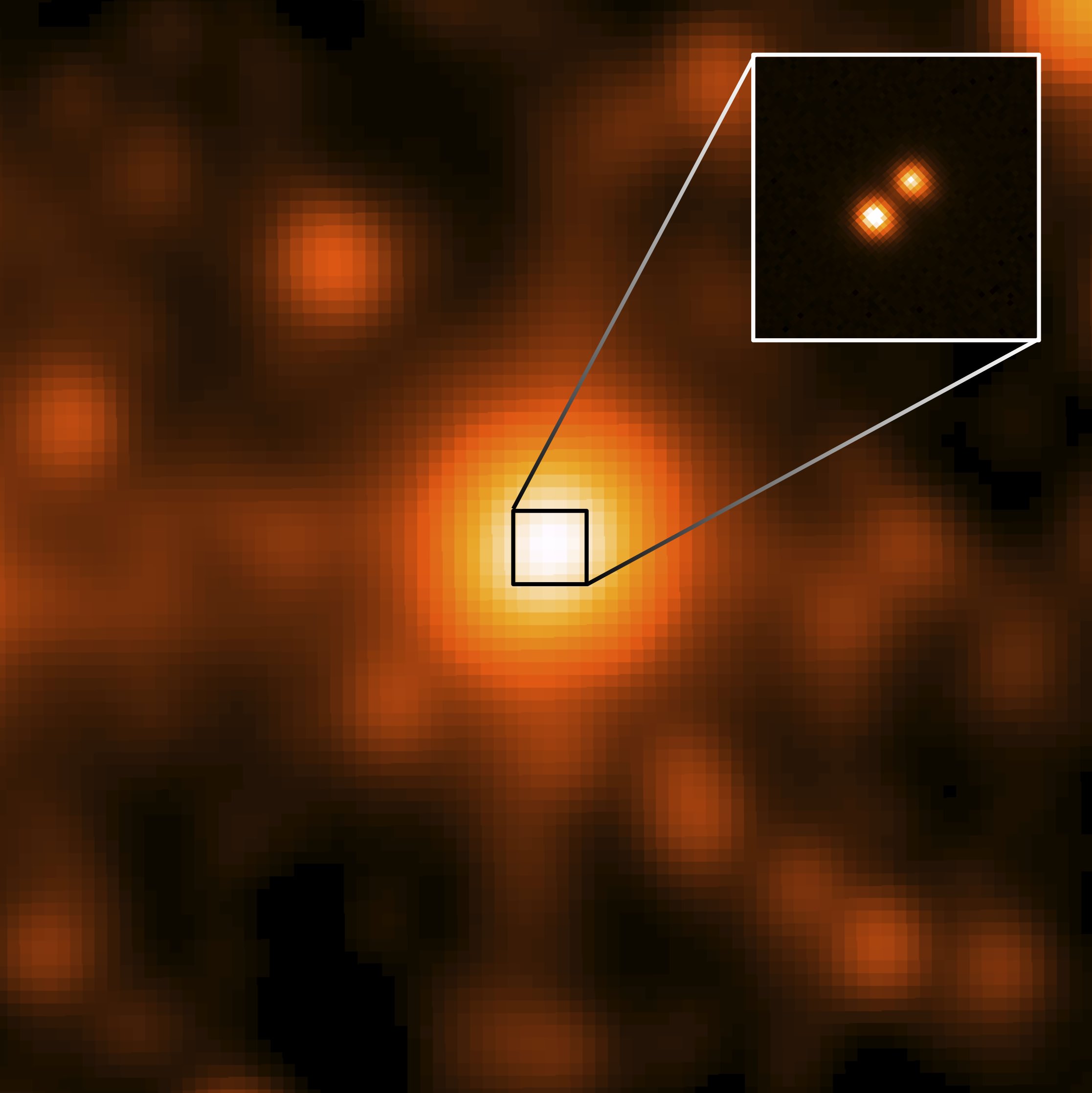
In 2012 astronomers announced the discovery of an Earth-like planet circling our nearest neighbor, Alpha Centauri B, a mere 4.3 light-years away. But with such a discovery comes heated debate. A second group of astronomers was unable to confirm the exoplanet’s presence, keeping the argument unresolved to date.
But not to worry. One need only look 2.3 light-years further to see tantalizing — although yet unconfirmed — evidence of an exoplanet circling a pair of brown dwarfs: objects that aren’t massive enough to kick-off nuclear fusion in their cores. There just may be an exoplanet in the third closest system to our Sun.
Astronomers only discovered the system last year when the brown dwarfs were spotted in data from NASA’s Wide-field Infrared Explorer (WISE). Check out a past Universe Today article on the discovery here. They escaped detection for so long because they are located in the galactic plane, an area densely populated by stars, which are far brighter than the brown dwarfs.
Henri Boffin at the European Southern Observatory led a team of astronomers on a mission to learn more about these newly found dim neighbors. The group used ESO’s Very Large Telescope (VLT) at Paranal in Chile to perform astrometry, a technique used to measure the position of the objects precisely. This crucial data would allow them to make a better estimate of the distance to the objects as well as their orbital period.
Boffin’s team was first able to constrain their masses, finding that one brown dwarf weighs in at 30 times the mass of Jupiter and the other weighs in at 50 times the mass of Jupiter. These light-weight objects orbit each other slowly, taking about 20 years.
But their orbits didn’t map out perfectly — there were slight disturbances, suggesting that something was tugging on these two brown dwarfs. The likely culprit? An exoplanet — at three times the weight of Jupiter — orbiting one or even both of the objects.
“The fact that we potentially found a planetary-mass companion around such a very nearby and binary system was a surprise,” Boffin told Universe Today.
The next step will be to monitor the system closely in order to verify the existence of a planetary-mass companion. With a full year’s worth of data it will be relatively straightforward to remove the signal caused by the exoplanet.
So far only eight exoplanets have been discovered around brown dwarfs. If confirmed, this planet will be the first to be discovered using astrometry.
“Once the companion is confirmed, this will be an ideal target to image using the upcoming SPHERE instrument on the VLT,” Boffin said. This instrument will allow astronomers to directly image planets close to their host star — a difficult technique worth the challenge as it reveals a wealth of information about the planet.
Once confirmed, this planet will stand as the closest exoplanet to the Sun, until the debate regarding Alpha Centauri Bb is resolved.
The paper has been accepted for publication as an Astronomy & Astrophysics Letter and is available for download here. For more information on Alpha Centauri Bb please read a paper available here and published in the Astrophysical Journal.
New Online Classes to Help You Learn More about the Universe

Roughly eighty percent of all the mass in the Universe is made of dark matter – a mysterious invisible substance responsible for the structure of galaxies and the patterns of the cosmos on the very largest scales. But how do we know that?
Astronomical images are beautiful, but that’s not their primary purpose from a scientist’s point of view. How can we take those images and infer things about what they are?
We only know of one planet harboring life: Earth. But that doesn’t mean we don’t know anything about the possibility of life elsewhere in the cosmos. How can we infer things about possible alien organisms when we can’t see them (yet)?
 If you’re curious about those and other classes, CosmoAcademy — a project from the CosmoQuest educational and citizen-science group — could be for you. We’re offering three new online classes: Introduction to Dark Matter, Introduction to Astronomy via Color Imaging, and Life Beyond Earth: Introduction to Astrobiology.
If you’re curious about those and other classes, CosmoAcademy — a project from the CosmoQuest educational and citizen-science group — could be for you. We’re offering three new online classes: Introduction to Dark Matter, Introduction to Astronomy via Color Imaging, and Life Beyond Earth: Introduction to Astrobiology.
These classes are short, four-hour courses designed for curious but busy people. All CosmoAcademy classes are offered online through Google+ Hangouts, a type of video chat. Part of the reason we do that is to limit the size of courses to eight students. That allows us to provide individual instruction in a way no other kind of online class is able to do – you aren’t a faceless student, but part of every discussion. In fact, if there’s a topic you want to discuss, there’s a good chance your instructor will take the time to talk about it.
Interested? See our course listings, and please let me know if you have any questions. Here are a few more details:
CQX015: Introduction to Dark Matter
Roughly eighty percent of all the mass in the Universe is made of dark matter – a mysterious invisible substance responsible for the structure of galaxies. But how do we know that? In this course, we’ll examine the evidence in favor of dark matter’s existence, from the rotation of galaxies to the radiation left over from the infancy of the cosmos. After that, we’ll examine what we can infer about the identity of dark matter and sketch out some of the experiments designed to detect it. This class assumes no background except a strong interest in astronomy and cosmology.
Instructor: Matthew Francis
Course structure: Two weeks, four 60-minute meetings
Meeting times: Tuesdays and Thursdays, 9–10 PM US Eastern time (6-7 PM US Pacific time)
Course dates: January 28—February 6, 2014
CQX021: Introduction to Astronomy Via Color Imaging
When astronomers look at a star, nebula or galaxy for the first time, they see some unreachably distant object acting in some unknown way. What does it have to be made of and how does it have to be acting to look like that? In this class we will be looking at how we use the visual appearance of astronomical objects to figure out what they are. We will examine this problem by making our own color images from the sources provided by observatories from real research projects. From the subtle hues of stars in a distant galaxy to the eerie neon colors of nebulae to the chaotic Sun, by looking at objects in the right light, we can find out what makes them tick.
Instructor: Peter Dove
Course structure: Two weeks, four 60-minute meetings
Meeting times: Tuesdays and Thursdays, 8–9 PM US Eastern time (5-6 PM US Pacific time)
Course dates: Tuesday, February 25—Thursday, March 6
CQX013 – Astrobiology: Life in the Universe
What will it take to find extraterrestrial life? Frank Drake penned his famous “equation” to determine the instances of life in the Galaxy over 50 years ago. Meant more as a discussion guideline than a rigorous mathematical formula, it will guide our discussion on the science of astronomy, biology, and astrobiology as we consider the possibility of life in the Universe.
Instructor: Nicole Gugliucci
Course structure: Two weeks, four 60-minute meetings
Meeting times: Mondays and Thursdays, 9–10 PM US Eastern time (6-7 PM US Pacific time)
Course dates: Monday, March 17 — Thursday, March 27

